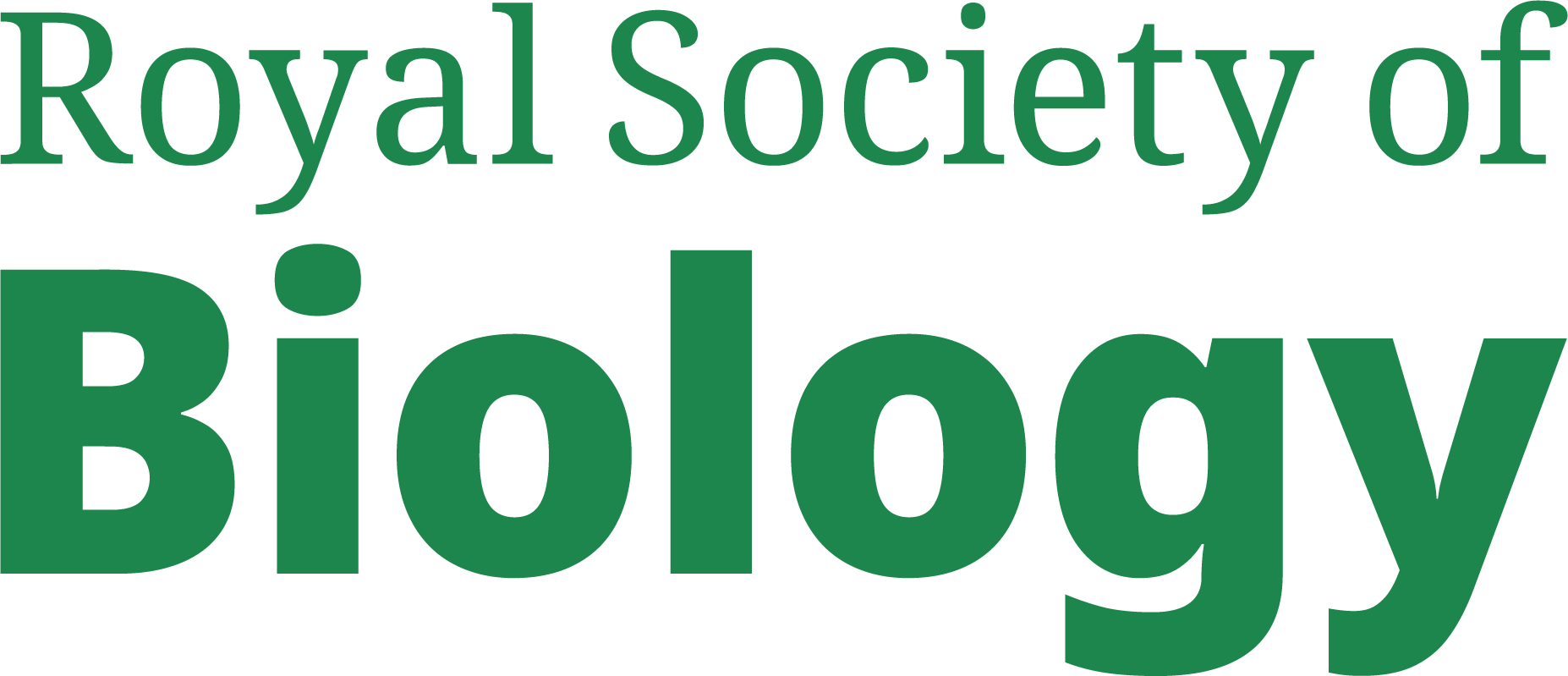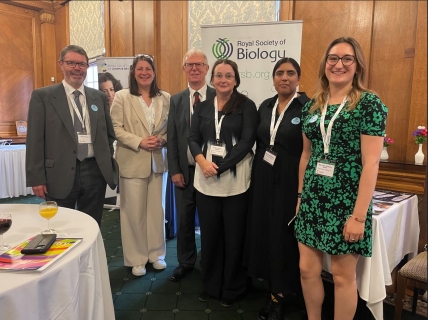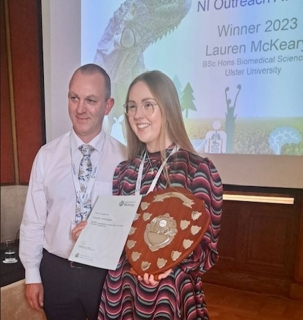News archive
Reports
- Details
- 15 May 2013
A new digital healthcare system - Encompass
12 November 2024
A comprehensive overview of experiences as an Encompass trainer and insight into a new digital healthcare system being implemented within Northern Ireland health trusts. It was also explained how this new system has the ability to create research opportunities and drive innovation within public, private and academia sectors.
During the talk, Daniel delivered a presentation utilising public information from the ‘Right Time Right Place’ and ‘Systems Not Structures’ report alongside the ‘e-Health and Care Strategy NI’ documentation. The presentation included a personalised story of how a career in biology has shaped his skill set and showed how many ever-expanding opportunities exist for the digital side of science. The presentation concluded with a question-and-answer session from attendees with key questions pertaining to the development, protection and safeguarding of healthcare systems and how best clinical practice can be achieved through system optimisation.
When asked to summarise Encompass, Daniel said,” The Encompass programme is one of the first universal digital HSC systems to be implemented which will deliver much needed change, creating a single integrated digital healthcare record for every citizen in Northern Ireland with the aim to provide patients and service users with the safest, highest quality of care that is possible”. Initially implemented in the South Eastern Health & Social Care Trust in November 2023, Encompass will be rolled out across all HSC Trusts in Northern Ireland by the end of 2025 to create better experiences for patients, service users and staff.”
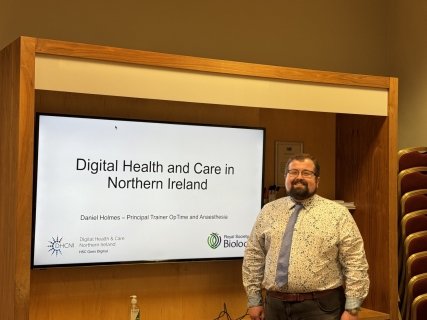
Following the presentation there was a committee meeting where the future of the Branch under the changes imposed by Head Office were discussed.
Daniel Holmes CBiol. MRSB
Trainer for HSCNI’s Business Service Organisation and Branch Committee Member
Summer Outing
26 June 2024
The 2024 Branch Summer outing was to Belfast’s famous Zoological Gardens in County Antrim, Northern Ireland. The zoo occupies a 55-acre site in a relatively secluded location on the northeastern slope of Cavehill overlooking Belfast Lough and is home to more than 1,200 animals and 140 species.
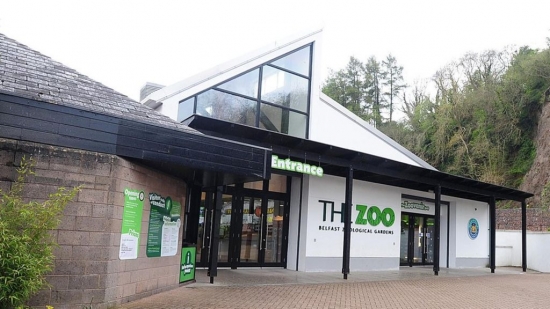
The trip was very enjoyable and provided members and their families ample opportunities to become acquainted in pleasant surroundings with some unusually clement weather. The group were especially impressed by the Zoo’s emphasis on conservation, especially with regard to endangered species. The zoo carries out extensive conservation work and takes part in over 90 international breeding programmes which help to ensure the survival of many species under threat. In addition to the gardens and animal enclosures there is a dedicated Education Centre which is busy mid-week with school groups. Throughout its 90-year existence the zoo has always kept Asian elephants (Elephas maximus) and a famous story from the past tells of a keeper concerned for the wellbeing of a baby elephant during the Belfast Blitz kept the elephant in her back garden overnight and walked her back to the zoo each morning! The group learned that elephants are the topic of recent news as their two remaining elephants, which are now quite old, are preparing for retirement in the Netherlands. Hopefully they will soon be replaced.
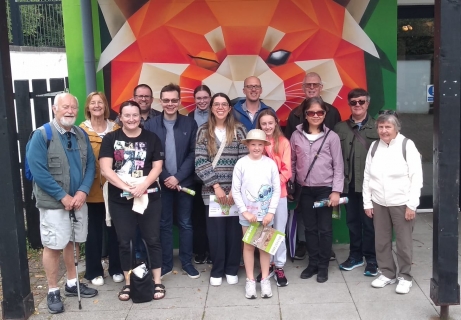
Opened in 1934, the zoo is the second-oldest in Ireland and is one of the top fee-paying visitor attractions in Northern Ireland, receiving more than 300,000 visitors a year. It is owned by Belfast City Council which spends over £2.5 million every year on its running and promotion. One of the few local government-funded zoos in the UK and Ireland. the zoo is continually evolving to become a centre of excellence and world leader in zoo-based conservation, education and experience. Their mission is to offer all communities the opportunity to learn and commit to the conservation of wildlife and wild places at home and abroad.

Dr Richard Briggs MBE CBiol. FRSB FLS
Branch Treasurer
Symposium for Global Young Talents (GYT) in Food Safety, Nutrition, Human Metabolic and Neurodegenerative Disease 2024
29 - 30 January 2024
The Symposium was Queen's University Belfast in collaboration with the Northern Ireland Branch of the Royal Society of Biology. Professor Nigel Scollan, Director of the Institute for Global Food Security (IGFS) at Queen's University Belfast (QUB), and Dr Qiaozhu Su, Vice Chair of the RSB NI Branch Committee and Associate Professor in the School of Biological Sciences/IGFS at QUB, extended invitations to Dr Liang Wang, President of the International Chinese Young Scholar Network in Nutrition in the USA; Dr Hanrui Zhang, Chair of the Women Leadership Committee in Arteriosclerosis, Thrombosis, and Vascular Biology (ATVB) Council in the USA; and Dr Wenhua Zheng, Professor at the University of Macau in China, to co-chair this international symposium for young investigators.
The aim of the Symposium was to cultivate a vibrant platform for young scientists to exchange ideas and foster international dialogue. The symposium gathered more than 250 participants globally, attracting a diverse audience from countries worldwide. The symposium featured three captivating keynote lectures delivered by renowned scientists, igniting inspiration among attendees. Professor David Grieve from QUB spoke on supporting the career development of postgraduate and postdoctoral researchers in the UK. Professor Peter J. Little from the University of Queensland, Australia, discussed ‘Diabetes mellitus - then, now, and in the future’. Professor Lawrence J. Cheskin from George Mason University/Johns Hopkins School of Medicine, USA, presented on ‘GLP-1 Receptor Agonists and Other New Pharmacotherapy for Obesity’. Two dynamic theme forum talks by Dr Xuehong Zhang from Harvard University, USA, and Dr Hongmei Tan from Sun Yat-Sen University, China, sparked thought-provoking discussions. These were complemented by engaging sessions of oral presentations and poster presentations featuring talented junior researchers from around the globe. A dedicated Career Development Discussion session, led by Dr Hanrui Zhang, Dr Zhen Chen and esteemed professors from the USA, UK, and China, provided invaluable guidance on career development for aspiring young researchers.
This international event unfolded as an exhilarating showcase of innovation and collaboration among well-established scientists, outstanding mid-career researchers, and young rising stars in biomedical research. The symposium was closed by celebrating the award winners of Best Oral Presentations and Best Poster Presentations, which recognized the emerging talent in the field of biomedical research. In conclusion, the Symposium for Global Young Talents in Science 2024 was a resounding success, fostering collaboration and igniting passion among the next generation of biomedical researchers.
Dr Qiaozhu Su FRSB, Branch Vice Chair
Science and Stormont
9 October 2023
This event is designed to foster close relations with policymakers and key stakeholders in cooperation with the Northern Ireland science and engineering community. A GeoEnergy discovery Centre was officially opened at the event at Parliament Buildings in the Stormont Estate. The theme of this twelfth annual event was Science Education in Northern Ireland.
Presentations were given by eleven prestigious speakers including among others Gerry Campbell, CEO , Council for the Curriculum, Examinations and Assessment who talked on Skills development through the NI Curriculum and Qualifications system; Dr Marie Cowan, Director of the Geological Survey of Northern Ireland; Professor Philip Hanna, Dean of Education for the Faculty of Engineering and Physical Sciences at Queen’s University Belfast spoke on Beyond Automation: Reframing STEM Education for the AI Era; Dr Diane Lees-Murdock, Ulster University, whose research at the Centre for Genomic Medicine is focused on epigenetic regulation in normal development and disease spoke on Genomic Healthcare Challenges in HE Interprofessional Education and Outreach and Professor Gill Reid, President of the Royal Society of Chemistry, UK whose recent research includes the development of metal-chelate scaffolds for binding the fluorine-18 radioisotope towards new positron emission tomography (PET) imaging agents. She is a recipient of the IUPAC 2023 Distinguished Women in Chemistry award. Key speakers and attendees participated in Panel discussions together with elected Members of the Local NI Assembly, Dr Steve Aiken and Dr Caoimhe Archbald. Over a dozen Professional bodies and stakeholders had stands at the important event including the RSB.
Royal Society of Biology N Ireland, Science and Stormont.. (L-R) Dr William Bonass, Dr Diane Lees-Murdock RSB, Dr Glenn Dickson RSB, Professor Katrina Campbell RSB, Shabana Brightley RSB and Freya Gadsden Botton RSB HQ.
RSB N Ireland Outreach Awards 2023 presented at Science and Stormont
The Royal Society of Biology introduced the N Ireland Outreach Award in 2018 to celebrate Biology in N Ireland by sharing the work of scientists with a wider public audience. Science communication skills are vital to encourage participation of public and patients in healthcare and research studies as well as delivering evidence-based information in a clear manner.
Chair of the RSB N Ireland Outreach Award, Dr Diane Lees-Murdock announced the award winners and thanked the judging panel, Dr Richard Briggs, Dr Glenn Dickson and Prof Katrina Campbell of the local RSB committee for their work in assessing the applications. The awards were presented by Professor Gill Reid, President of the Royal Society of Chemistry. First place was awarded to Lauren McKeary, Biomedical Science student at Ulster University for her demonstrated commitment to scientific outreach through participation in a broad range of activities such as production of a pharmaceutical video on successful completion of the Ulster University-Randox Training Academy. Lauren featured in Ulster University prospectus and course videos, sharing her experience of studying Biomedical Science and undertaking a placement in a hospital laboratory, encouraging other young people to consider studying STEM at university. Second Place was jointly awarded to Emily Royle (PhD Researcher, Food, Nutrition & Dietetics, Ulster University) and Aileen Lynch (PhD Research, Microbiology, Queen’s University Belfast) while third place was awarded to Yasna Najmi, PhD Researcher in Pharmaceutical Sciences, Ulster University.
RSB Northern Ireland Outreach Award 2023. Overall Winner Lauren McKeary (Ulster University), pictured with her father at the prize ceremony at Science in Stormont 2023
Dr Glenn Dickson CBiol FRSB
Rathlin Island
10 June 2023
The 2023 summer outing was to Rathlin Island off the North Antrim coast of Northern Ireland. The trip comprised of a boat trip aboard MV Spirit of Rathlin followed by a 4.5 mile bus journey to the newly renovated RSPB West Light Seabird Centre.
Rathlin has Northern Ireland's largest seabird colony along with quite spectacular panoramic coastal scenes. At the Seabird Centre, the group enjoyed close-up views of a colony of 250,000 nesting seabirds with razorbills, puffins, fulmars, guillemots and kittiwakes which occurs annually from late April to July. A wide range of other fauna and flora were seen during the trip and included grey seal (Halichoerus grypus) and harbour seal (Phoca vitulina).
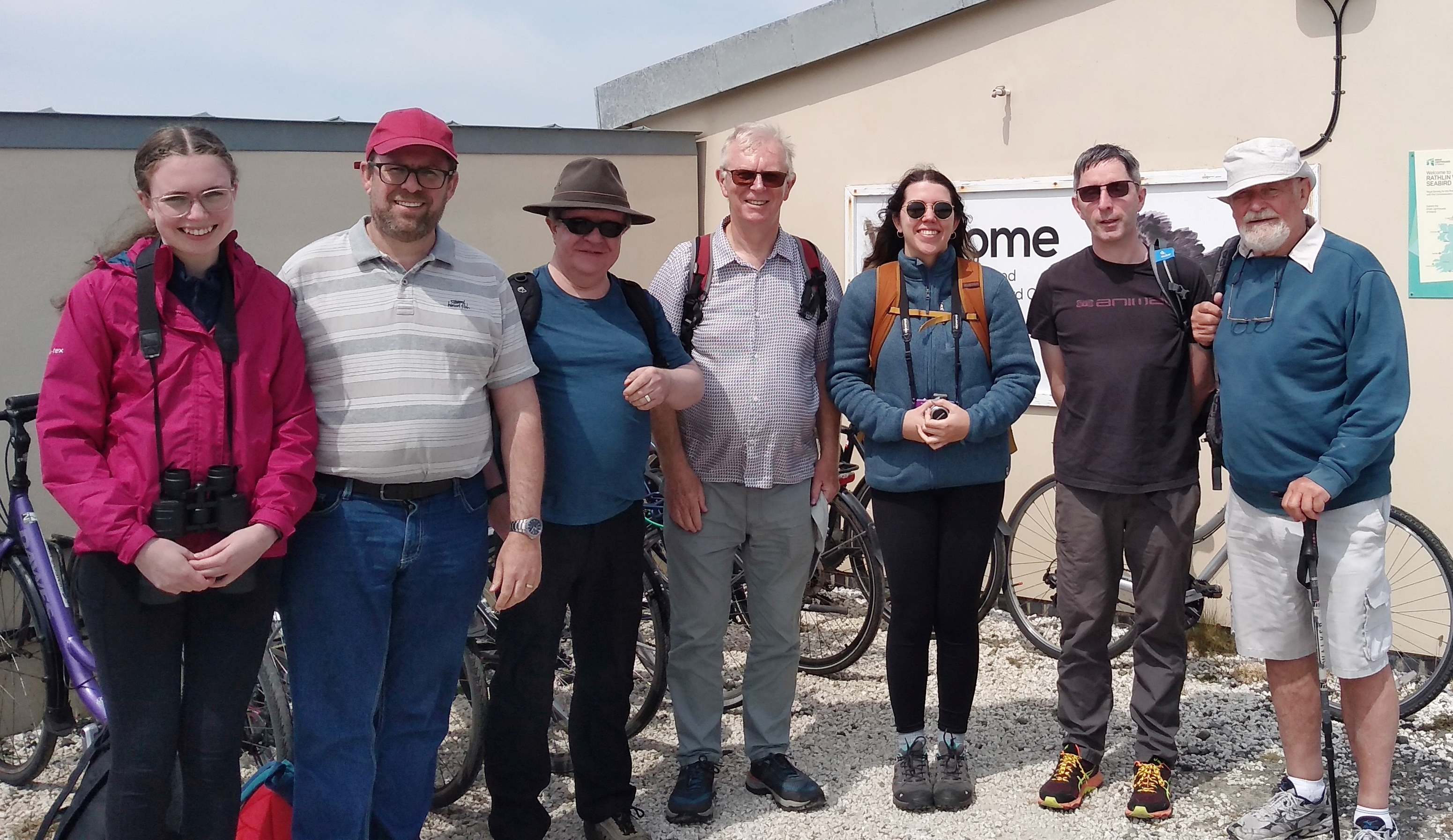
Some of the RSB group outside the RSPB Bird Reserve
Rathlin is Northern Ireland's only inhabited offshore island, with a population of about 150 people. the reverse L-shaped Island is four miles (six kilometres) from east to west, and 21⁄2 miles (4 kilometres) from north to south. Rathlin is one of 43 Special Areas of Conservation in Northern Ireland. There is much history associated with the Island including Bruce's Cave named after Robert the Bruce. It was here that he was said to have seen the legendary spider which is described as inspiring Bruce to continue his fight for Scottish independence.
Also of historical note was that the world's first commercial wireless telegraphy link was established by employees of Guglielmo Marconi between East Lighthouse on Rathlin to Kenmara House in Ballycastle on 6 July 1898.
Dr Richard Briggs MBE CBiol FRSB
Visit to Hilden Brewery
12 May 2023
Following an introductory sample of one of Hilden’s lighter beers, called Belfast Blonde served in their Georgian courtyard the group were welcomed by brewery manager Owen Scullion.
Owen explained that Hilden, Ireland's Oldest Independent Brewery, has spent 40 years perfecting the production of craft beers. He then gave brief details of Hilden House, it's original owner and their world-renowned Barbour Threads Linen Mill.
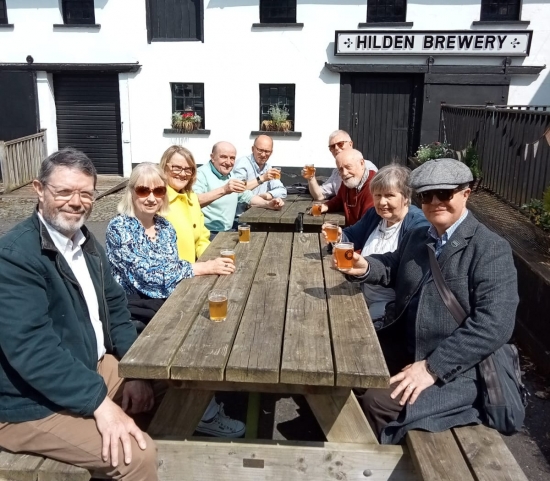
The group enjoying a sample of Belfast Blonde prior to the tour
This was followed by a tour of the brew houses where he described how craft beers were made. The key ingredients are grain, usually barley, water, hops and yeast. The flavour is adjusted by manipulating different amounts of these ingredients and careful temperature control. The process begins with the barley, which is harvested and processed to produce malt. The malt is steeped in hot water to activate the enzymes which break down the starch to simple sugars. This is the wort which is then boiled and hops are added to enhance the aroma. The liquid is then cooled and transferred to a fermentation vessel where yeast is added to produce carbon dioxide and alcohol.
The tour was concluded with a visit to Hilden’s new automated bottling and canning plant. We were then treated to a lunch of beef stew made with Hilden’s own Irish stout. Not only does Hilden Brewery have a very productive brewhouse, it also has a modern coffee shop and restaurant that offers quirky brewery weddings and has a unique conference venue offering a brilliant opportunity for tourists to experience authentic Northern Irish hospitality in a setting of real Irish heritage.
Dr Richard Briggs MBE CBiol FRSB
Science and Sormont
17 October 2022
The 2022 Science and Stormont Conference was a face to face meeting held in the Long Room of Parliament Buildings, Stormont, Belfast. The Conference is designed to foster close relations with policymakers and key stakeholders, and is organised by the Royal Society of Chemistry on behalf of, and in cooperation with, the Northern Ireland science and engineering community. The 2022 Conference was the tenth annual Science and Stormont event and the theme was “Building our future: Research and innovation in Northern Ireland.” Attendees included Northern Ireland branch Committee members Professor Louise Cosby (RSB Council Member), Professor Katrina Campbell, Dr Glenn Dickson, Professor Gerry McKenna MRIA and Dr Richard Briggs along with Susie Rabin, associate director of parliamentary and public affairs from RSB Head Office. The Conference was chaired by Dr Steve Aiken OBE MLA who is chair of the Northern Ireland Assembly All-Party Group on STEM. The programme comprised of the following presentations:
- Dr Ben Bleasdale from the Campaign for Science & Engineering: Discovery Decade project: helping R&D reach new public supporters
- Professor Vincent Fusco, Queen’s University Belfast: Ingredients for a research and innovation culture
- Professor Phil Jordan, Ulster University: The agri-environment: Pathways to research impact
- Dr Vicky Kell, director of Invest NI’s Innovation, Research & Development: The Northern Ireland innovation landscape
- Professor Helene McNulty MRIA, Ulster University, Coleraine: IUNA – A bottom-up example of all-Island research excellence
- Dr Liam O’Hare, Queen’s University Belfast: Developing social innovation through community and university partnerships: Queen’s Innovation Zone
- Professor Ultan Power, Queen's University Belfast: Respiratory virus pandemics and epidemics – are we ready?
- Rachael Singleton, Northern Ireland Innovation Lab: Behavioural science in action: Policy starts with people
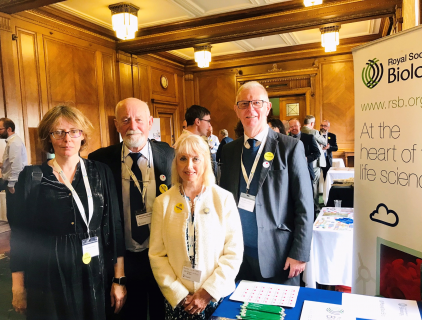
The Conference concluded with a panel of MLAs including Dr Stephen Aiken OBE MLA and Dr Caoimhe Archibald MLA, Vice-Chair, NI Assembly All-Party Group on STEM.
Dr Richard Briggs MBE FRSB FLS
Belfast AGM 2022: Hannibal’s Great Adventure … comes to Belfast
2 June 2022
Professor Chris Allen FRSB, from Queen’s University Belfast, provided a presentation on his research into the route that the Carthaginian General, Hannibal, took when he crossed the Alps with his army circa 218 BC to commence the second Punic war.
Chris is a microbiologist by training, and has been attempting to use molecular ‘metagenomic’ methods to detect the remnants of the gut microbiome associated with grazing horses – that may have left a 2000 year old trail of faecal materials at a critical ‘watering hole’ near the famous Col de Traversette. This pass lies between Italy and France, and was one of the highest routes available to the great army as it invaded the homeland of ancient Rome.
Even today, historians argue and speculate as to the exact route Hannibal took, as they did in antiquity. Chris gave a short outline of the problem and discussed the writings of Polybius – who followed some 50 years after the event - and how they may point, tantalisingly, to the Col de Traversette as Hannibal’s elusive route. A balanced overview was provided. Chris attempted to bring together both ancient and modern findings to explain the likely route the great man took.
Chris especially highlighted the importance of interdisciplinary research in helping to solve this problem, and how biologists can contribute in many perhaps unconventional ways to serve diverse research activities.
Professor Chris Allen CBiol FRSB and Dr Richard Briggs MBE CBiol FRSB
Viruses and the Virosphere
10 February 2021
Members of the County Armagh Wildlife Society, Armagh Natural History and Philosophical Society and Northern Ireland branch of the RSB met via Zoom to hear Dr Matthew Jebb, director of the National Botanic Gardens of Ireland, give a whirlwind tour of the virosphere.
It has been estimated that each day 800 million viruses fall on each square metre of our planet. Most are bacteriophages of Synechococcus, a marine cyanobacterium and the most numerous life form on Earth. Bacteriophages cause about a third Synechococcus to rupture each day, and enable marine nutrient cycling to occur.
Meanwhile on the African savannah viral pathogens of wildebeest are understood to influence fires and tree density through the ‘Rinderpest trophic cascade hypothesis’. That is, control of Rinderpest results in more wildebeest and less grass. A reduction in grass results in less fires, which allows more trees to grow.
Phage therapy is generally considered a recent development. However, the ancient healing power of the Ganges River can be explained by its exceptionally high concentration of bacteriophages, which destroy Vibrio cholera (causal agent of cholera).
The Arc gene has been identified as being essential for long term memory in animals. Interestingly, Arc proteins self-assemble into virus-like capsids and exhibit properties similar to some retroviral proteins. This discovery raises the question of where did our long term memory come from? Moving from the mind to the gut, we learnt that we are dependent on bacteriophages for much of our nutrition. If bacteriophages did not break down bacteria in our guts, then the nutrients would remain locked up in bacteria and lost during defecation. Recognition of the role of viruses in human nutrition is relatively recent; for example, the most abundant gut phage, CrAssPhage01, was only identified in 2014.
In conclusion, our general disdain for viruses (SARS-CoV-2 was noted) is looking increasingly myopic.
Dr Paul Matthews CSci CBiol MRSB
AGM and Lecture: Overview of COVID-19 Vaccines and Tests with Parallels in Veterinary Medicine
25 March 2021
Following the formal AGM business, branch chair Professor Chris Allen FRSB introduced the speaker Professor Louise Cosby FRSB, head virologist of the veterinary sciences division, Agri-Food and Biosciences Institute, Belfast, and emeritus professor, Wellcome Wolfson Institute for Experimental Medicine, Queen’s University Belfast. Professor Cosby gave a comprehensive lecture entitled Overview of COVID-19 Vaccines and Tests with Parallels in Veterinary Medicine.
The lecture covered the basis of a range of COVID-19 diagnostic tests and vaccine strategies as well as discussion of virus variants and vaccine protection against these. The basic principles of diagnostic tests for SARS CoV-2 virus antigens (antigen lateral flow and the gold standard Roche electrochemiluminescence (ECL) tests) were covered as well as assays for virus RNA, including standard polymerase chain reaction (PCR), quantitative multiplex PCR and loop mediated amplification tests (LAMP). The sensitivity and specificity of each type of test was highlighted.
Comparisons were made with the molecular veterinary virus testing carried out by Virology Branch in the Agri-Food and Biosciences institute (AFBI) in Belfast and why the degree of similarity and comparable accreditation status with hospital labs allowed rapid transition to COVID-19 testing by AFBI Virology. The range of COVID-19 vaccines on the market was outlined and each type of vaccine design as well as how virus antigens are delivered to cells in the body explained. A brief overview of the types of immunity induced by the vaccines was given. Comparisons were also made with in-house approaches such as the joint Queen’s University Belfast and AFBI projects for veterinary recombinant vaccine virus development.
The Covid-19 virus variants, including where the mutations occur in the virus genome and how this effects virus loads and/or virus transmission, was described. The basis of the virus serum neutralisation test, which determines the degree of protection that current vaccines give against the variants, was outlined. Finally, the need for vaccine evolution based on this information was discussed.
The full lecture is available to watch on the RSB YouTube channel.
Professor Louise Cosby FRSB
Biology Week: Ash Dieback, Sudden Oak Death, Ash Sawfly...: Why are the incidences of tree diseases increasing?
9 October 2019
Dr Richard O’Hanlon of the Agri-Food and Biosciences Institute gave this year’s Biology Week Lecture, which was hosted by the County Armagh Wildlife Society and the RSB Northern Ireland Branch.
Pest epidemics occurring in Irish trees are not a new phenomenon. Pollen deposits in peat bogs indicate that approximately 4000 years ago a Dutch elm-like disease almost wiped out the Irish populations of elms. Thankfully, in the centuries that followed the populations recovered.
Irish woodlands have always enjoyed relative protection from pest epidemics by virtue of their situation: being on an island at the edge of Europe. Numerous reports from past centuries indicate Irish woodlands were noticeably healthier than their continental and British relatives. Escalating globalisation of trade has resulted in increasingly more diseases becoming established in mainland Europe and Britain, and inevitably finding their way to Ireland, typically nine years after being first observed in Britain. For example, Ash dieback was first observed in Poland in 1995, was widespread in Eastern Europe by 2005, was widespread throughout continental Europe (except Iberia, Britain and Ireland) by 2010, and by 2015 was established in both Britain and Ireland.
In the face of more pending epidemics, the natural question is ‘what can be done?’ Three recommendations were given. First, improved monitoring and detection: high tech detection techniques (DNA analysis); industry and public awareness (including public uptake of the TreeCheck App); and focusing resources on the highest risks. Secondly, greater cooperation between research, industry, the public and the National Plant Protection Organization. Finally, more resilient forests: improved bio-security, especially for forestry operations and machinery; increased variety of tree species; and increasing the range of tree ages within a forest. Although more pest epidemics of Irish trees is anticipated, there is a way forward.
Dr Paul Matthews CSci CBiol MRSB
Antibiotic Discovery in the Post-Antibiotic Era
20th March 2019
Prof. Brendan Gilmore (Queen’s University, Belfast) gave the fourth Annual Norbrook Royal Society of Biology Lecture. We were reminded that the 1940s-1970s hay-day of antibiotic discovery is long past, and that in the past few decades few novel antibiotic classes have been discovered. Although reports of antibiotic resistance are commonplace today, the phenomenon was observed by Sir Alexander Fleming, who wrote: “The thoughtless person playing with penicillin treatment is morally responsible for the death of the man who succumbs to infection with the penicillin-resistant organism. I hope this evil can be averted.”
In the pre-antibiotic era over half of deaths were caused by infectious diseases. Antibiotics have reduced this figure to 3% in the USA. However, the rise of antibiotic resistance has, according to the Office of National Statistics, caused for the first time a drop in life expectancy. Increasing loss of antibiotic efficacy will mean surgical procedures and organ transplants will become more difficult or even impossible. The cumulative cost to global GDP by antimicrobial resistance by 2050 has been estimated to be $100 trillion.
To conclude his lecture, Prof. Gilmore explored the reasons behind why the antibiotic discovery pipeline appears to be blocked. One factor is economics. Currently, the return on investment for bringing a new antibiotic to market is not commercially appealing. Secondly, as only 1% of the microbiome is culturable, enhanced culture and identification from untapped niches needs to be explored. Prof. Gilmore’s own work has demonstrated that the Archaea may be an untapped source of antibiotics. His team has cultured over 400 haliphiles from the Kilroot salt mines in Northern Ireland, with many isolates expressing antimicrobial compounds. Although this does not represent the discovery of new clinically relevant antibiotics, it does demonstrate the potential for novel antibiotic discovery in the Post-Antibiotic Era.
Dr Paul Matthews CBiol CSci MRSB
Summer Outing - A botanist's delight!
15 June 2019
Royal Society of Biology members, from across Northern Ireland, along with their friends and families, gathered at the stunning north coast Blue Flag Beach, Portstewart Strand for the annual summer outing.
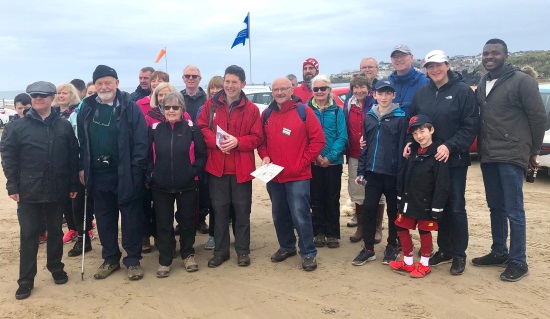
Attendees at the Northern Ireland Summer Outing. Photo credit Mr Chris Murdock.
They were guided by National Trust rangers through the extensive sand dune system where various species of orchids can be found. Covering around two miles and taking in some breath-taking scenery, members spotted bee orchids, marsh orchids and pyramidal orchids in their natural habitat. The rain held off well to ensure that the afternoon outing was an active and enjoyable occasion.
Dr Diane Lees-Murdock CBiol FRSB
Galapagos – Evolution & Global Change with Liz Bonnin
24 February 2019
The Galapagos Islands are famed as the biological wonderland where Charles Darwin conceived his theory of natural selection. However, these islands are becoming an increasingly popular tourist destination, which, along with the effects of environmental change, has significant implications for the vast array of unique biodiversity found here.
As part of the Northern Ireland Science Festival 2019, the Royal Society of Biology and Queen’s University Belfast, School of Biological Sciences, hosted a fascinating event featuring BBC presenter Liz Bonnin. The event, organised by Professor Chris Allen, vice chairperson, RSB NI branch, had an enthusiastic response from the public, scientific community and student body, resulting in a sell-out audience of over 250 attending the eagerly anticipated event.
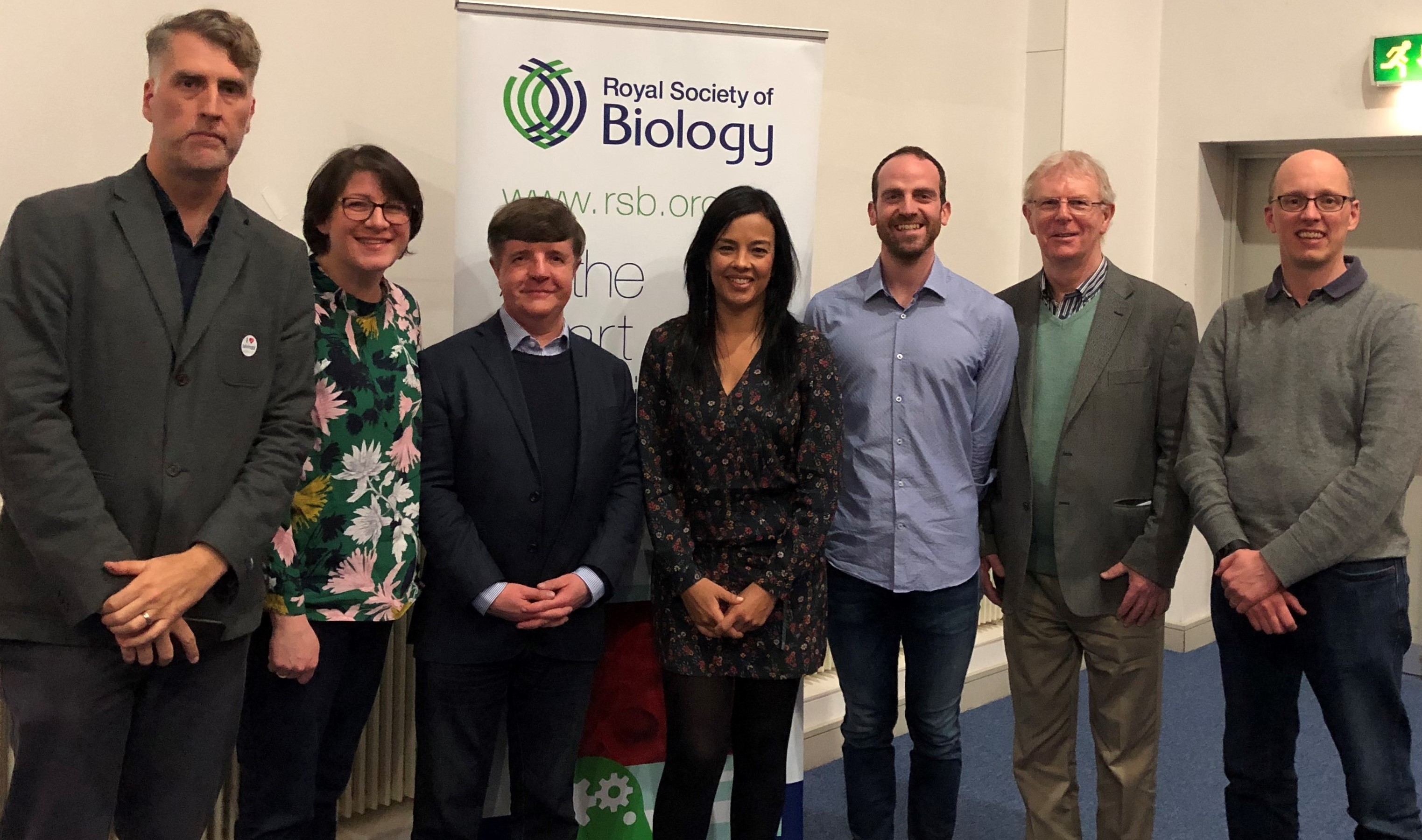
Photo 1: Liz Bonnin entertained an enthralled audience at the Northern Ireland Science Festival 2019 hosted by Royal Society of Biology and Queen’s University Belfast School of Biological Sciences. Liz is pictured with the RSB NI Branch Committee (from left) Professor Chris Allen (RSB NI Branch, Vice Chairperson, Event Organiser), Dr Diane Lees-Murdock (RSB NI Branch, Chairperson), Professor Neville McClenaghan, Liz Bonnin, Jonathan Shields (RSB NI Branch Hon Sec), Dr Glenn Dickson & Dr Patrick Dunlop.
Liz presented her experiences aboard the research vessel Alucia, as she embarked upon a scientific expedition across these islands to help protect their remarkable biodiversity. She enthralled the audience with clips and stories from the popular BBC series in which she joined scientists working to protect the endangered pink iguana; journeyed one kilometre into the ocean abyss surrounding the islands to catch a glimpse of elusive new species; abseiled into a lava cave; and dived in the ocean to help investigate hammerhead shark activities in order to provide future protection for these magnificent creatures.
Liz was joined by Queen’s University Belfast academics from the School of Biological Sciences: Dr Jonathan Houghton, a marine biologist who works in the Galapagos today who outlined international efforts to preserve the rich underwater diversity, and Professor Chris Allen who discussed how Darwin’s theory has led to exciting technologies that are delivering incredible innovations.
The speakers fielded questions from the audience before Liz posed for photos with many of the audience members.
Dr Diane Lees-Murdock CBiol MRSB
Beneficial Insects: what they eat (and should we eat them?)
10 October 2018
Dr Archie Murchie of the Agri-Food and Biosciences Institute gave this year’s Biology Week lecture. The lecture was dedicated to the memory of Ron Williams, a former secretary of the County Armagh Wildlife Society, who recently passed away.
Paradoxically, we want to see biodiversity in the field, but we do not want to see it wiggling on our plates. This is a challenge to entomologists, especially as a fifth of all direct yield losses to crops are caused by animals, including insects, and the global demand for food continues to increase.
Pesticides can be remarkably effective at controlling undesirable insects. DDT reduced malarial cases in Italy from 400,000 in 1945 to virtually zero in 1950. However, not all effects of pesticides are welcome. Neonicotinoid use has recently been drastically regulated because of their adverse effect on bee populations. Reports of a ‘75% decline over 27 years in total flying insect biomass in protected areas’ have been attributed to changes in land use and pesticides. There is an urgent need to find more selective and sustainable insect control methods.
Parasitic wasps have proven to be excellent biological control agents of some pests, and can reduce our dependency on chemical insecticides. Insects may help in food production (as biological control agents and as pollinators), but there is potential for them to be our food; particularly the softer, less chitinous developmental stages of larvae and pupae. Since public acceptability is a hurdle, but in the short-to-medium term it is expected that insect protein will become increasingly utilised in fish and poultry feeds.
The event finished with light refreshments, including a selection of edible insects.
Dr Paul Matthews CBiol CSci MRSB
RSB Outreach Award presented at Science at Stormont
8 October 2018
The Northern Ireland branch committee have instigated a new nationwide annual award for final year undergraduates who have demonstrated outstanding commitment and passion for science outreach. The inaugural award was presented to Rebecca Kilgore, a recent graduate of the BSc Hons biology course at Ulster University. The presentation took place during Science and Stormont during Biology Week 2018.

Rebecca founded, along with her course director, a new RSB affiliated student society for bioscience undergraduates on her Ulster University campus, which she went on to chair. Rebecca also led the student society in developing a number of events designed to target school-aged males from underprivileged backgrounds to encourage their participation in university level bioscience courses where they are traditionally under-represented e.g. biomedical sciences.
Rebecca and her team also organised a workshop for the Northern Ireland Science Festival and designed a workshop for local primary schools.
Rebecca has gone on to study for a PGCE at Newcastle University and could not attend the ceremony in person. Therefore her father Mr Edward Kilgore and her sister Miss Jordan Kilgore received the award on Rebecca’s behalf. The award was presented by RSB NI branch Chairperson Dr Diane Lees-Murdock.
Dr Diane Lees-Murdock CBiol MRSB
Trip to Rathlin Island
27 June 2018
The 2018 summer outing was to Rathlin Island, off the coast of north Antrim, Northern Ireland. The trip comprised of a 25 minute boat trip aboard MV Rathlin Express followed by a short bus journey to the newly renovated RSPB West Light Seabird Centre.
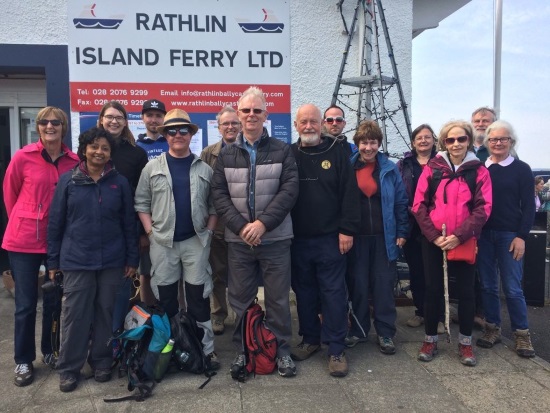
The RSB group waiting for MV Rathlin Express trip to Rathlin Island
Rathlin has Northern Ireland's largest seabird colony along with quite spectacular panoramic coastal scenes. At the Seabird Centre the group enjoyed close-up views of the colony, with razorbills, puffins, fulmars, guillemots and kittiwakes congregating in their thousands to breed, which they do from late April to July.
A wide range of other fauna and flora were seen during the trip, including grey seal (Halichoerus grypus), harbour seal (Phoca vitulina) and one member spotted the rear Irish hare (Lepus timidus).
Rathlin is Northern Ireland’s only inhabited offshore island, with a population of about 150 people. The reverse L-shaped Rathlin Island is one of 43 Special Areas of Conservation in Northern Ireland. There is much history associated with the Island including Bruce's Cave, named after Robert the Bruce. It was here that he was said to have seen the legendary spider which is described as inspiring Bruce to continue his fight for Scottish independence.
The world's first commercial wireless telegraphy link was established by East Lighthouse on Rathlin to Kenmara House in Ballycastle on 6 July 1898.
Dr Richard Briggs CBiol FRSB FLS
Drug Delivery Strategies for the 21st Century
26 March 2018
Professor John Callan, the Norbrook Chair in Pharmaceutical Science at Ulster University, gave this year’s Annual Joint Norbrook Laboratories and RSB Lecture, attended by approximately 50 people.
Most medical conditions are localised (headaches, infections etc.), and while some common drug delivery vehicles such as inhalers do manage a degree of targeted drug delivery, other common vehicles (tablets, injections) saturate the whole body with pharmaceutical agents. Ideally, drugs should be delivered directly to the desired site.
John’s collaborative research is exploring the use of drug-loaded microbubbles for the treatment of pancreatic cancer. Gas-filled microbubbles have been routinely used as a contrast agent in ultrasound scanning for decades. Iron oxide nanoparticles and off-patent chemotherapy agents are attached to these physiologically benign oxygen-filled microbubbles. After the microbubbles have been injected, a focused magnetic field, acting on the iron oxide, is used to concentrate the microbubbles proximal to the cancerous tumour. The microbubbles are subsequently burst using low intensity ultrasound to release the chemotherapy agents and oxygen. The localised delivery of the drugs reduces the amount required by two-orders of magnitude, and the presence of oxygen enhances the effectiveness of the drugs.
Since physiological effects of microbubbles, oxygen and the off-patent drugs are well characterised, the regulatory hurdles to trial this treatment in humans are reduced, and John’s team are hopeful such a trial could commence early next year.
Pancreatic cancer has the worst survival rates amongst the 21 most common cancers. This novel treatment is not a silver-bullet, but it is hoped it will downstage tumours so surgery is possible in more patients. Currently, surgery is the only treatment that can cure pancreatic cancer, but less than 20% of patients diagnosed are eligible for curative surgery. ‘Downstaging’ tumours will hopefully increase the number of patients eligible for surgery.
Dr Paul Matthews CSci CBiol MRSB
Ginger Genetics
20 February 2018
A lively crowd packed into the Black Box venue for the Belfast Science Café February meeting, where Dr Declan McKenna took to the stage to present his entertaining lecture 'Ginger Genetics: A Celebration of Red Hair'.
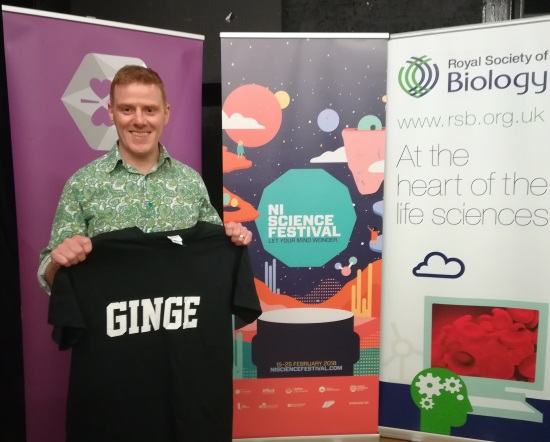
Dr Declan McKenna preparing to take the stage at the Northern Ireland Science Festival 2018
The event was part of the 2018 Northern Ireland Science Festival and proved very popular, especially with redheads who were keen to understand more about the science behind their fiery hair colour.
A proud redhead himself, Dr McKenna discussed the 'ginger gene', explaining how it affects hair colour and why it is so common in this part of the world. Along the way, he explored the cultural significance of red hair throughout human history, tackled the subject of 'gingerism' and used science to debunk a few myths about supposed redhead traits.
Feedback on the night was very positive from the large audience, with several enthusiastic 'ginger-nuts' and 'carrot-tops' in attendance. Social media promotion for the event was strong and Dr McKenna was subsequently invited to record interviews with local radio stations to discuss the topic.
Earlier in the day, Dr McKenna, senior lecturer in the School of Biomedical Sciences at Ulster University, presented the same seminar to over 100 A-level biology students from local schools at the Ulster Coleraine campus, in conjunction with the STEM HUB NI education team from W5 Interactive Discovery Centre, Belfast.
Both events were sponsored by the Northern Ireland RSB Branch, with prize t-shirts kindly donated by Ginger Parrot, a website for people with red hair. Thanks to all who attended!
Declan McKenna FRSB
Biology Week lecture
11 October 2017
Plant taxonomist Dr Caroline Pannell gave the annual joint County Armagh Wildlife Society and RSB Biology Week lecture on ‘Wallace’s Line’ and the biogeographical contrast between Australasian and South-east Asian forests.
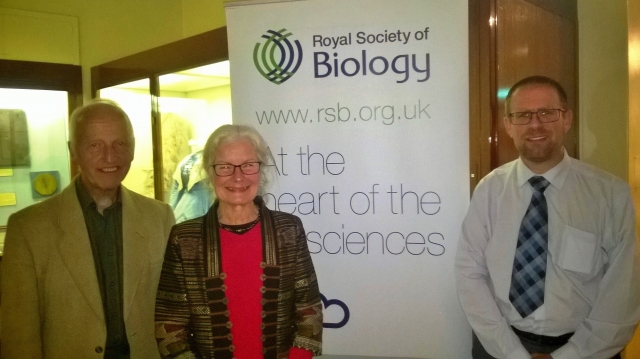 Left to right: Dr John Faulkner, Chairman County Armagh Wildlife Society, Dr Caroline Pannell, Speaker, Dr Paul Matthews, RSB(NI) Committee Member
Left to right: Dr John Faulkner, Chairman County Armagh Wildlife Society, Dr Caroline Pannell, Speaker, Dr Paul Matthews, RSB(NI) Committee Member
The first contrast highlighted was between tropical rainforests and temperate forests. The former typically have 300+ different species of tree per acre, receive at least 1.6 metres of rain per year (but up to 10), are consistently warmer than 18°C and their seeds are primarily dispersed by animals. Temperate forests have a maximum of 40 tree species per acre, are cooler, usually drier, and seed dispersal is more often by wind.
The faunal dividing line between these groups is known as the Wallace-Huxley line, which approximates to the continental shelf that passes between the islands Bali and Lombok and Lydekker’s Line, demarcating the western edge of Australasia. The deep waters and rapid currents that flow between Bali and Lombok have been a barrier to dispersal for millions of years. Plants, being more sedentary than animals, would be expected to follow a similar separation along the Wallace-Huxley line. However, the tree genus Aglaia (family Meliaceae), Dr Pannell’s principal area of interest, is found throughout the Malay Archipelago. Vertebrates such as fruit-pigeons, whose distribution is similar to that of Aglaiai, have probably been responsible for carrying seeds across the faunal boundaries.
The talk concluded with questions and friendly discussion regarding the relative challenges facing floral and Porifera (sponges) taxonomy.
Dr Paul Matthews CSci CBiol MRSB
Science & Stormont 2017
9 October 2017
The sixth annual Science & Stormont conference was hosted by the Royal Society of Chemistry and facilitated by Dr Steve Aiken, vice-chair of the Northern Ireland All-Party Group on STEM at Stormont, the seat of the Northern Ireland Assembly.
RSB’s Northern Ireland branch was well represented, and the event provided an opportunity to meet Dr Jane Magill, the Society’s regional co-ordinator, and Stephen Benn, the Society’s director of parliamentary affairs.
Following a welcome by Dr Aiken and introductory remarks by Dr Helen Pain, deputy chief executive of the Royal Society of Chemistry, the conference kicked off with the first group of speakers. Professor Gerry McKenna and Dr Marie Cowan provided an overview of the preliminary conclusions of the Royal Irish Academy’s Brexit Taskforce, which painted a gloomy picture of science funding and the movement of overseas students after Brexit.
Dr Yvonne Armitage, a bio-economy specialist who chairs the RSB Employer Advisory Board, then gave a stimulating presentation entitled “Understanding DNA: Bioscience is much more than biology in today’s laboratory”. The second session was opened by Brian Doran from the Northern Ireland Southern Regional College, who gave an informative presentation on the evolution of science apprenticeships in Northern Ireland. This was followed by a presentation on bridging the skills gap between university and business by Lorraine Marks. Gareth Hetherington then described the importance of identifying the skills required for tomorrow’s economy and Professor Robert Bowman concluded the session by tracking the evolution of postgraduate training and experience.
On a lighter side, Dr Stephen Benn lobbied delegates to vote in the RSB’s “favourite UK Tree” poll, which was subsequently won by the horse chestnut Aesculus hippocastanum.
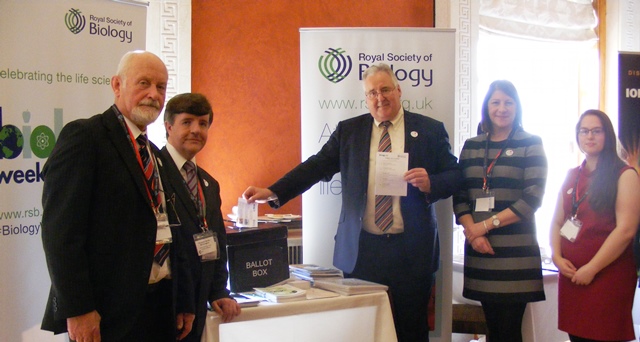 Dr Stephen Benn with members of the Northern Ireland Branch Committee manning the favourite tree polling box.
Dr Stephen Benn with members of the Northern Ireland Branch Committee manning the favourite tree polling box.
Dr Richard Briggs CBiol FRSB
Fresher's Fayre at Ulster University
27 September 2017
For the first time in history the Northern Ireland Branch attended the Fresher's Fayre at Ulster University (Coleraine Campus). The Faye is an Open Day for the University clubs and societies who erect displays of their activities with a view to attracting new members. In addition to the University organisations, a number of outside bodies are represented, from the RSPB to local businesses and charities.
The Society's stand displayed the activities of the branch in addition to information highlighting the advantages of student membership. The event was a great success with many students of the biological sciences showing an interest and over thirty of these expressing an interest in joining the Society.
Dr Richard Briggs CBiol FRSB
Belfast Marine Laboratory open day
15 July 2017
The Queen's University Marine Laboratory is based in Portaferry, on the shores of Strangford Lough, Northern Ireland's first Marine Conservation Zone where the marine flora and fauna are among the most diverse in the North Atlantic.
The visit commenced with a seminar by Dr Carola Becker, a Queen's University Research Fellow, on age determination in decapod crustaceans with particular reference to the Dublin Bay Prawn Nephrops norvegicus, which forms Northern Ireland's largest fishery.
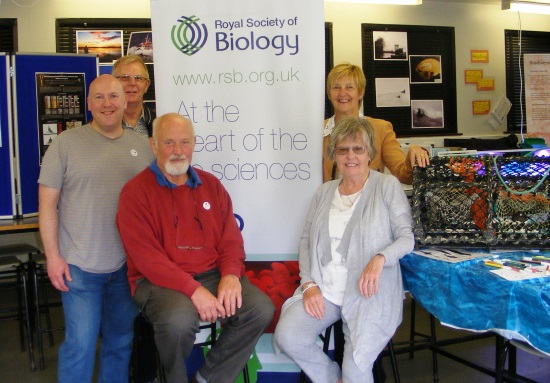
Dr Becker's presentation was followed by a tour of the laboratories and the adjoining teaching laboratory which housed displays of the centre's research and an RSB stand. The Open Day was visited by over 350 people ranging from fellow scientists to members of the public and their families.
In the afternoon the group had a complimentary tour of the recently re-opened Exploris Marine Aquarium.
Exploris manager Ann Moreland explained how the marine communities in the aquarium are arranged to enable visitors to gain an understanding of the biology and inter-relationships between species in the marine ecosystem.
Brendan, our guide led us through displays of native species followed by colourful coral reefs of the tropical oceans and then to the dark depths of the Amazon rainforest where examples of its reptilian inhabitants were viewed.
The aquarium includes a seal sanctuary which allows visitors to see the process of rehabilitation of rescued seal pups which are eventually released back into the wild.
Dr Richard Briggs CBiol FRSB
The role of animals in feeding a growing global population
29 March 2017
Simon Doherty (animal science & aquaculture specialist for the UK Government’s Department for International Trade) gave this year’s Annual Joint Norbrook Laboratories and RSB Lecture. In his wide-ranging talk, Simon sought to challenge the audience’s thinking regarding the future of food production.
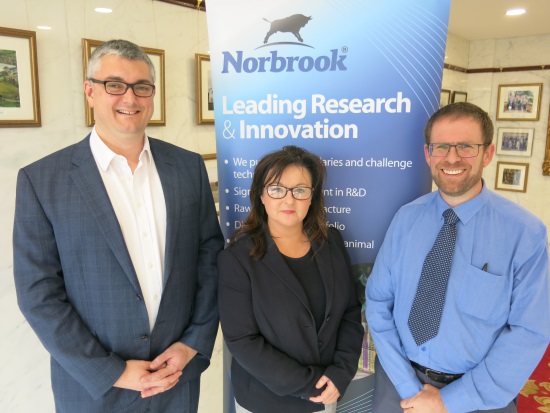
We may assume that the majority of beef is reared on giant feedlots and that cornbelts provide the majority of cereals, but one third of the world’s population are smallholder family farmers who produce nearly 70% of all food consumed.
Therefore, technologically sophisticated innovations may not always be necessary to increase food production. In sub-Saharan Africa, where the charity Send a Cow works with smallholder farmers, milk output from the average cow has increased from being insufficient for the family’s dietary requirement to there being a surplus for sale (funding school and university education).
Happily, some graduates are returning home and developing the nascent dairy industry – including the establishment of supply chains.
Continuing the dairy theme, Simon asked the audience how India produces more milk than the whole of the EU. The answer is buffalo milk production must not be excluded from the calculation. Increases in food production are likely to come from unlikely sources, including buffalo and even lyophilised insects.
The future of food production will undoubtedly include innovations. For example, within the concept of ‘One Health’ animal vaccines are preferred to treatments since prevention is deemed better than cure. However, new classes of antibiotics are also required, not just new antibiotics, to treat both humans and animals.
The talk concluded with pertinent questions from the audience, including musings on the global carrying capacity of Homo sapiens.
Dr Paul Matthews CBiol CSci MRSB
Generation Innovation’s ‘Night of Ambition’
8 March 2017
Committee members of the Northern Ireland branch contributed to the ‘Generation Innovation Night of Ambition’ event in Belfast with a stand and display of RSB promotional material.
The event took place at St George’s Market and was attended by over 200 teenagers, aged 15-18.
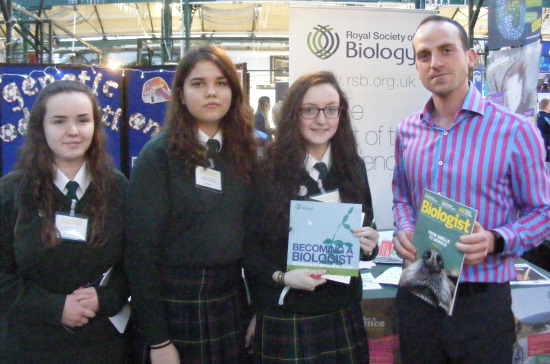
‘Generation Innovation’ is seeking to inspire teenagers from every discipline – STEM, computing, art, music, business studies - to consider careers in this developing sector.
Established in 2011, Generation Innovation (generationinnovation.co.uk) is run by the Northern Ireland Science Park, a non-profit organisation.
Students, teachers, parents and founders of local innovation companies listened to presentations by a selection of speakers. Local names to support Generation Innovation include Chris McClelland, CEO of Belfast startup Brewbot; Colin Williams, Founder of the Sixteen South TV production studio; and Suzanne Saffie-Siebert, Founder of SISAF, a ground-breaking biotech firm.
The programme also included an opportunity for the teenagers to take part in activities aimed at developing innovative ideas in science and technology. In addition to the RSB there were exhibits by a range of organizations including Sentinus, W5 and STEM along with a several small startup companies. Although Deloitte Digital was the main sponsor the principle funder was the Department of Culture, Arts and Leisure NI, along with Core Systems, Equiniti and Ulster University.
Now in its sixth year over 3,000 young people from 125 schools have participated over this period and in 2016 88% of the teenagers attending said they would consider a career in Innovative sectors.
Diane Morrow, a programme manager for Generation Innovation, commented that 2017 had been the most successful event to date. She also thanked the RSB for their contribution along with the sponsors and other contributors who made the evening such a success.
Dr Richard Briggs CBiol FRSB
A level Update Lecture
22 February 2017
Over 200 A level biology students from local schools were welcomed at Ulster University (UU), Coleraine for this year’s A level biology update for schools lecture, sponsored by the Northern Ireland Branch.
This year’s event was held as part of the Northern Ireland Science Festival in conjunction with the STEM HUB NI education team from the W5 Interactive Discovery Centre, Belfast.
Dr Declan McKenna, lecturer in haematology in the School of Biomedical Sciences at UU, discussed the wonderful world of blood in his presentation “Blood, Glorious Blood!”
Over the course of an entertaining hour, Declan began by outlining the cultural significance of blood in human society before progressing to explain various scientific properties of blood. To make the subject accessible, Declan used topical references to movies, books and celebrities, as well as telling stories about medieval history, sports, medical misfortunes and scientific breakthroughs. There was even a Boney M impression thrown in for good luck!
Feedback on the day was universally positive and both pupils and teachers were delighted at how the informative lecture complemented their A-Level studies by covering aspects of immunology, blood transfusion, haemoglobin and DNA technology.
Students also had a short talk from Professor Stephen McClean, Professor of Bioscience Education at UU, about various university courses available in life & health sciences, as well as career options related to biology. This was very informative for the pupils, helping them to understand the wide range of options available to them after their A-Level studies.
Thanks to all who attended!
Dr Declan McKenna FRSB
Cleanrooms in pharma
11 October 2016
Production of sterile drugs is subject to strict controls mandated by regulatory authorities.
Dr Paul Matthews works as a senior environmental microbiologist within the Environmental Microbiology Department at Norbrook Laboratories, Newry, County Down. Paul described how these measures are typically implemented in pharmaceutical manufacturing facilities.
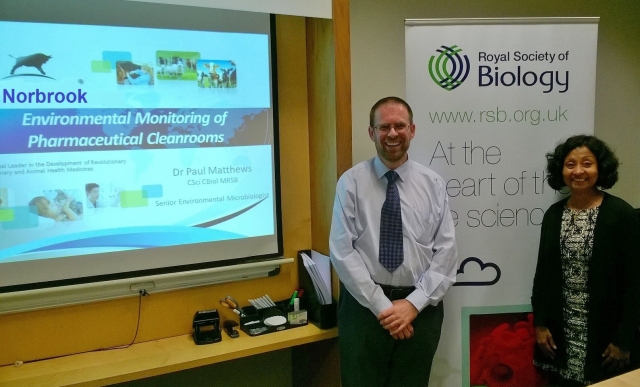
A cleanroom is an area which has been designed so that the airborne levels of particles (microbial and non-microbial) are kept within defined limits. We saw how the various steps of the process are carried out in different cleanrooms which, depending on the stage of the operation, have different classifications required.
For example, filling of a sterile product into its final container must take place in a ‘Grade A’ environment, whereas less critical processes, such as preparation of bulk solutions prior to sterilisation, can be carried out at lower Grades such as C or D.
Paul described the key ways in which control of these classified areas is maintained such as specialist operator clothing requirements or ‘gowning’, material transfer procedures, and the associated personnel and material flows. We then looked briefly at basic design and control factors that maintain the cleanroom environment, such as non-porous, non-shedding and easily cleanable construction materials and a continuous air supply which delivers high-grade, HEPA filtered air.
To confirm that all these measures are effective and that the required levels of control are being maintained routine, environmental monitoring must be carried out. This testing includes sampling of air and surfaces to check for levels of microbial contamination, airborne particle concentrations and positive pressure differentials.
Dr Stephen Cooper MRSB
Invasive Species
12 October 2016
Professor Jaimie Dick, an invasion ecologist and director of the Queen’s University Marine Laboratory, gave the annual joint County Armagh Wildlife Society and RSB Biology Week lecture. Jaimie presented his subject at local and global scales with wide ranging examples.
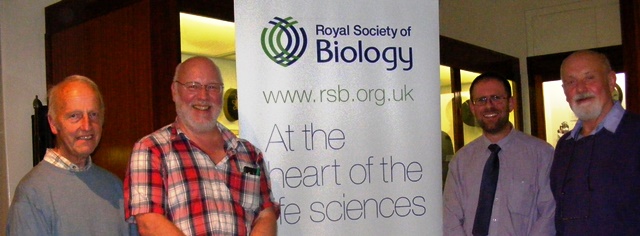
The Stephen’s Wren, whose range was limited to a single island, was exterminated by a single invasive animal: the lighthouse keeper's cat. At the continental scale, the construction of the Rhine–Main–Danube Canal allows boats to move easily from the Caspian and Black seas to Northern Europe, along with any hitch-hikers; for example, the zebra mussel, which is now found in the waterways of Ireland, although it is a native to Southern Russia.
Jaimie augmented his examples with science. For example, the loss of red squirrels by the invasive grey squirrel is not solely through resource competition, but is enhanced by the grey squirrel being an asymptomatic carrier of squirrel pox, which is lethal in red squirrel populations.
Invasive species are far from being an artefact of academic curiosity. The estimated annual global cost of invasive species is US$1 trillion.
Within a Northern Ireland context the increasing frequency of muntjac deer sightings must rouse concern. The lack of competition to munjac in Northern Ireland, coupled with does typically reaching sexual maturity after several months, means the current small local population has the potential to grow very quickly.
To mitigate the environmental and economic impacts of invasive species legislation has been passed, but resources to enforce the legislation and monitor invasive populations are inadequate. Needless to say, invasive species and their impact on our lives will not be going away.
The talk concluded with questions and reports of possible local muntjac sightings from the audience.
Dr Paul Matthews CSci CBiol MRSB
Science & Stormont 2016
10 October 2016
This year’s conference was once again hosted by the Royal Society of Chemistry and facilitated by Naomi Long, chair of the Northern Ireland All-Party Group on Science and Technology at Stormont, the seat of the Northern Ireland Assembly.
Attendees included most of the learned societies for science, technology, engineering and mathematics along with Northern Ireland Assembly Members.
The Northern Ireland branch of the RSB was well represented and there was an opportunity to meet the Society’s director of parliamentary affairs, Dr Stephen Benn FRSB, who is a regular at the Stormont event.
Stephen’s role includes maintaining relationships with the UK Government in order to promote Biology and the Society. The theme of this year’s conference was antimicrobial resistance. Following a welcome and brief introduction by Professor Sir John Holman, president of the Royal Society of Chemistry, there was a presentation entitled “Together against the bugs: scientific and political leadership on a mission” by the chief medical officer for Northern Ireland, Dr Michael McBride.
This was followed by a series of keynote presentations which highlighted the problems associated with the use of antibiotics in medicine, and included an address by Dr Patrick Dunlop MRSB who is a member of the Northern Ireland RSB branch committee.
Dr Dunlop’s presentation dealt with a multidisciplinary approach towards tackling the problems of microbial resistance.
The day was concluded by brief presentations by assembly members Naomi Long and Caoimhe Archibald, with closing remarks by Professor Sir John Holman.
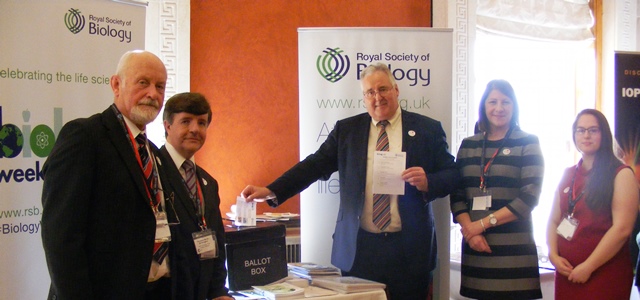
On a lighter side Dr Benn lobbied delegates to vote in the RSB favourite UK mammal poll. Of the delegates present the red squirrel (Sciurus vulgaris) came out on top, with the bottlenose dolphin (Tursiops truncates) a close second.
Dr Richard Briggs CBiol FRSB FLS
Summer outing to Belfast Zoo
25 June 2016
The Northern Ireland branch held their annual member’s summer outing at Belfast Zoo and due to the good weather and the venue, the committee were delighted to welcome a total of 30 attendees.
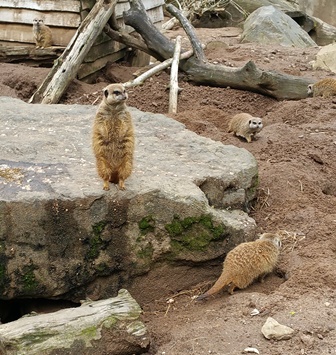
During the visit we were able to see a wide range of animals including the ‘top’ attractions such as elephants, giraffes, lions, penguins, sea lions and apes. Belfast Zoo is the most popular tourist attraction in Northern Ireland and they are very active in promoting conservation and engaging with the local population. It was quite surreal at times seeing such animals in the backdrop of Belfast Lough or the slopes of Cave Hill.
During the visit we were delighted to be able to see Lola the Malayan Sun Bear cub, born only weeks previously and on her first ventures outside her den.
We were able to hear directly from her keeper about the difficulties the zoo has experienced keeping and breeding bears but also the very rewarding sights of Lola exploring; climbing rocks and trees, swinging in her hammock and sunbathing.
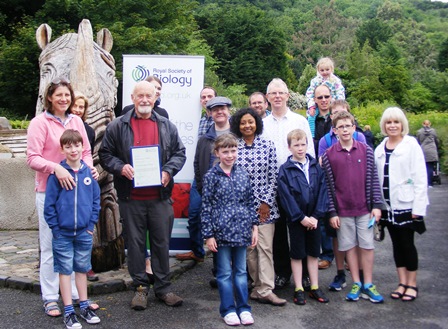 The committee were also delighted to present the RSB Long Service Award to Dr Richard Briggs, awarded for his many years of dedicated service to the branch and to biology. The zoo was an excellent setting for the presentation, reflecting Richard’s professional working with marine biology.
The committee were also delighted to present the RSB Long Service Award to Dr Richard Briggs, awarded for his many years of dedicated service to the branch and to biology. The zoo was an excellent setting for the presentation, reflecting Richard’s professional working with marine biology.
Each year the NI Branch Committee arranges a summer outing, along with many other events throughout the year. These events are open to members and we would be delighted to see you there – keep an eye on the branch’s webpage and your email for updates.
Jonathan Shields AMRSB
A level Biology Lecture at Ulster University
24 February 2016
Over 200 A level biology students packed into the Octagon Theatre at Ulster University (UU) for this year's Schools A level Update lecture, sponsored by the Northern Ireland RSB branch in conjunction with the STEMNET education team from the W5 Interactive Discovery Centre, Belfast.
Dr Declan McKenna, a lecturer in the School of Biomedical Sciences at UU, presented a very enjoyable lecture which explained how DNA technology has revolutionised the fight against viral infection.
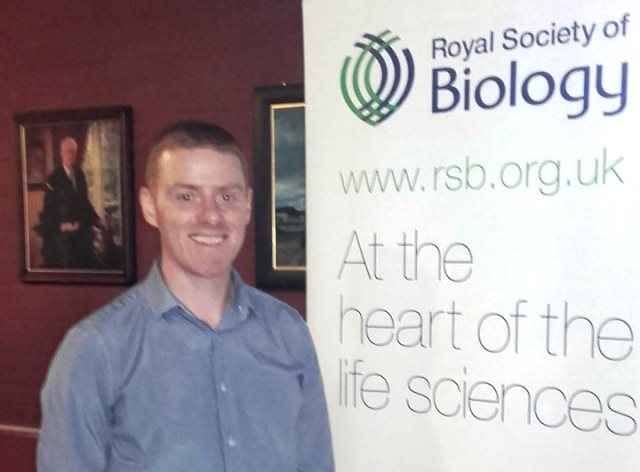
Structured around the fascinating story of HIV, Declan's lecture covered a number of topics relevant to the A level biology syllabus, including the human immune system, the viral life cycle and how vaccines work. He mapped out the origins and spread of the AIDS pandemic, explaining how researchers across the world used cutting-edge molecular biology techniques to understand how HIV worked and to battle against its spread.
The lecture was educational and stimulating, with many entertaining analogies and stories to make the subject accessible and memorable. Feedback on the day was universally positive and both pupils and teachers were delighted at how the lecture complemented their A level studies.
Following the lecture, Professor Jacqueline McCormack, associate head of School of Biomedical Sciences at UU, also gave a short talk on the various opportunities open to those interested in pursuing a career in biology. Pupils and teachers had the chance to talk to UU staff about the various courses available in life & health sciences, from biomedical sciences to pharmacy to stratified medicine. It was very informative for the pupils, helping them to understand the wide range of options available to them after their A level studies.
Declan McKenna CBiol CSciTeach MRSB
Environmental Reservoirs of Antibiotic Resistance
7 March 2016
Dr Fiona Walsh of Maynooth University addressed this topical subject for this joint Norbrook Laboratories-RSB lecture.
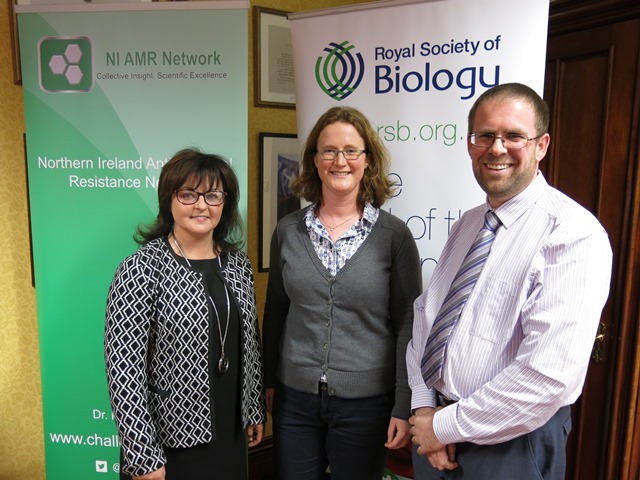
Antibiotic resistance (AR) is a major threat not only to human health, but also animal health, food production and the environment. It is estimated that antibiotics and vaccines have added twenty years to our lives, but in the last 25 years no new classes of antibiotics have been developed.
The majority of clinically significant antibiotic producing microorganisms have been isolated from soils; however, only 1,400 published papers have addressed AR in soils, whereas over 100,000 have focused on AR in humans. Ironically this bias could be justified since evidence indicates soils may not be the ultimate source of AR genes. The human gut contains a greater diversity and relative abundance of AR genes than other microbiomes (including soils and mammals). Why this is the case has yet to be determined.
"One Health" is a concept that recognises the relationship between disease and health in humans, animals and the environment, and is being used to examine reservoirs, sinks and flows of AR in ecosystems. For example, waste water treatment plants release water containing antibiotics. Currently, there are regulatory requirements for treatment plants to control toxic chemicals and indicator bacteria (E. coli etc.), but not antibiotics or AR genes. This lack of control allows antibiotics and AR genes to be cycled within the environment: biosolids are used in composting and agriculture; and discharged water is used by domestic, industrial and agricultural end-users.
Although we would welcome new antibiotics, there is clear a need to implement technological solutions to prevent antibiotic contaminants and AR genes entering and cycling in the environment. Dr Walsh's talk concluded with a lively audience discussion.
Dr Paul Matthews CBiol CSci MRSB
Generation Innovation Night of Ambition
2 March 2016
The purpose of the "Night of Ambition", organised primarily by the Northern Ireland Science Park, was to inspire young people to consider careers in Northern Ireland's growing knowledge economy.
Committee members of the Northern Ireland branch contributed to the evening with a stand and display of the Society's promotional material. The event took place at St George's Market in Belfast and was attended by over 200 teenagers, aged between 15 and 18.
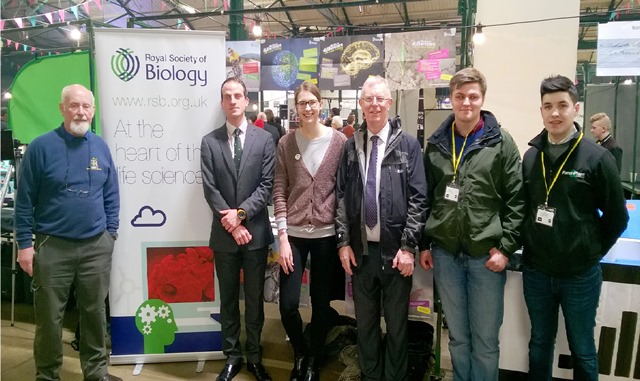
There was an 'Innovation Market Area' and stage where the students, accompanied by founders of local companies listened to presentations by a selection of speakers. These included Rachel Gawley, CEO of AppAttic and Mark Dowds, co-founder of Trov Inc., a Silicon Valley company focused on reinventing the insurance industry. The teenagers and founders then took part in a mini 'design thinking workshop' aimed at developing innovative ideas in science and technology.
In addition to the RSB there were exhibits by a range of organisations including the Institute of Physics, Young Enterprise Northern Ireland, Sentinus, W5 and STEM along with a range of small startup companies such as Skunkworks Surfboard Company and Equinutritive.
Claire Burgoyne, programme manager for Generation Innovation, commented that 2016 was the fifth year the Northern Ireland Science Park had organised the event and this year's had been the most successful to date. She also thanked the Society for their contribution along with the sponsors and other contributors who made the evening such a success.
Dr Richard Briggs CBiol FRSB
Badgers & Bovine tuberculosis – a black-and-white issue?
14 October 2015
Dr Andrew Byrne from the Agri-Food and Biosciences Institute addressed this topical subject for the annual County Armagh Wildlife Society & Biology Week lecture. Andrew, an ecologist by training, focused on the science behind the issue and deftly avoided the emotive policy debate.
Badgers spend considerable time in soils and are exposed to soil Mycobacteriaceae. Consequently, they show limited immunological response to M. bovis, the causal agent of bovine TB (bTB), but can transmit the pathogen to other badgers through biting and inhalation.
There is evidence that implicates badgers in transmission of bTB to cows. Through molecular and genomic studies, and experimentally, it has been shown that bTB can be passed intraspecifically and interspecifically in overlapping cow and badger populations.
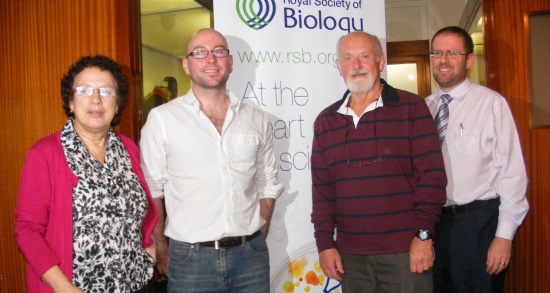
L-R: Professor Stephanie McKeown (Past-Chair of RSB NI branch), Dr Andrew Byrne (Speaker), Dr Richard Briggs (Hon treasurer of RSB NI branch), Dr Paul Matthews (committee member of RSB NI branch)
On the efficacy of culling badgers, Andrew reviewed several studies and illustrated that the ecology of culling is complex. Extreme culling is associated with a long lasting reduction in bTB, but culling can perturb the territorial boundaries of adjacent badger groups which, it has been suggested, can increase the potential for infected badgers to infect new hosts.
The potential for vaccinating cows was also addressed, but this is complex too. We currently lack a test to differentiate between vaccinated and infected cattle.
It transpired that badgers and bTB is a problem particular to the UK and Ireland. This is possibly because our badger density is on average 2-8 times higher than continental Europe, which in turn may be due to our climate or even our reluctance to manage badger populations. In Germany 50,000 badgers are typically killed each year through hunting. The talk concluded with a lively audience discussion.
Dr Paul Matthews CBiol CSci MRSB
Science & Stormont 2015
12 October 2015
This event was hosted by the Royal Society of Chemistry and facilitated by Basil McCrea MLA, Chair of the Northern Ireland All-Party Group on Science and Technology at Stormont, the seat of the Northern Ireland Assembly. It was attended by learned societies from science, technology, engineering and mathematics along with several Northern Ireland Assembly Members (MLAs).

Pictured left to right: Leigh Jeffes (Royal Society of Chemistry), Dr Richard Briggs (NI branch treasurer), Dr Stephen Benn (Royal Society of Biology) and Clare Viney (Royal Society of Chemistry)
The Northern Ireland branch was also well represented and there was an opportunity to meet the Society's director of parliamentary affairs, Dr Stephen Benn, who maintains relationships with the UK Government.
The theme of this year's conference was 'energy and the environment'. The opening address was by Ms Anna Lo MLA and included a summary of the recommendations of a recent enquiry into wind energy in Northern Ireland.
This was followed by presentations from keynote speakers on heat pumps, low-carbon and sustainable energy perspectives, sustainable waste water recycling, clean energy, land usage, flooding issues and earthquakes.
On a lighter side Dr Benn lobbied delegates to vote in the RSB favourite UK insect poll which was subsequently won by the buff-tailed bumblebee, Bombus terrestris, with over 40% of the votes.
Dr Richard Briggs CBiol FRSB FLS
Branch AGM
8 October 2015
This year's AGM was held at the Holiday Inn, Antrim and was far better attended than in previous years. It was encouraging to see many non-committee members attending, with a total of 16 present.
Professor Stephanie McKeown summarised a very successful and event-filled year and the imposed financial changes for the forthcoming year.
There were then a number of elections held. Five members were voted to Ordinary Committee Member: Dr Katrina Campbell, Dr Stephen Cooper, Professor Louise Cosby, Miss Rebecca Cuckoo and Dr Declan McKenna. The new honorary chair is Dr Moira Dean and the new honorary vice chair is Dr Diane Lees-Murdock. The honorary past chair is now Stephanie McKeown. It was rewarding to be able to vote in new committee members, particularly from a wide range of disciplines.
Following the AGM business there was an excellent lecture from Professor Neville McClenaghan, from the School of Biomedical Sciences at the University of Ulster. Professor McClenaghan's lecture was entitled "Innovations to challenge the global diabetes epidemic" which highlighted the upward trend in diabetes, especially the Type 2 form which is linked to life style and obesity. We were presented with some very stark facts and heard about the novel and world-leading research being pursued by the University of Ulster.
Jonathan Shields AMRSB
Rathlin Island
28 June 2015
Our 2015 summer outing was to Rathlin Island off the north Antrim coast of Northern Ireland. A 25 minute boat trip aboard MV Rathlin Express was followed by a three hour walk around the southern Roonivoolin region of the island in the capable hands of RSPB guide Liam McFall.
The group enjoyed a packed lunch whilst taking in the magnificent views of the north Antrim coast over Park Cove. Rathlin is the only inhabited offshore island off Northern Ireland, with a population of just over 100 people. The reverse L-shaped Rathlin Island is 4 miles (6 km) from east to west, and 2.5 miles (4 km) from north to south. The highest point is Slieveard at134 metres (440 feet) above sea level. Rathlin is one of 43 Special Areas of Conservation in Northern Ireland and is home to tens of thousands of seabirds, including common guillemots, kittiwakes, puffins and razorbills – about thirty bird families in total.
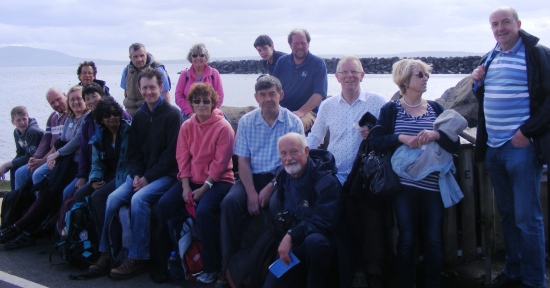
The RSPB has successfully managed the natural habitat to facilitate the return of the Red-billed Chough (Pyrrhocorax pyrrhocorax) and the group was lucky to see Northern Ireland's only breeding pair of Choughs along with this year's fledglings. A wide range of other fauna and flora were seen during the trip and included grey seals (Halichoerus grypus), harbour seals (Phoca vitulina) and greylag geese (Anser anser).
There is much history associated with the Island including Bruce's Cave named after Robert the Bruce. It was here that he was said to have seen the legendary spider which is described as inspiring Bruce to continue his fight for Scottish independence. The world's first commercial wireless telegraphy link was established by employees of Guglielmo Marconi between East Lighthouse on Rathlin to Kenmara House in Ballycastle on 6th July 1898.
Dr Richard Briggs CBiol FRSB
Celebrating Women in Science at the Soapbox Science Festival
20 June 2015
The Society sponsored my participation in Soapbox Science (along with EuroStemCell and NERC), a festival celebrating eminent women scientists from the UK and Ireland (www.soapboxscience.org). Branch committee members Professor Stephanie McKeown (chair) and Jonathan Shields (secretary) joined me and my colleagues from Ulster University, who came along to the event as volunteers to help record statistics and engage the public.
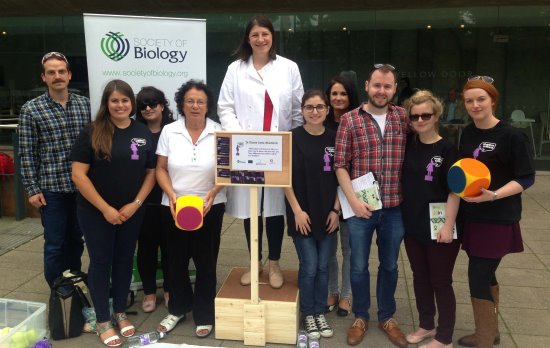
Soapbox Science is a valuable forum for female academics to talk to the general public about their work and passion for science, technology, engineering and maths. The festival plays an important role in eliminating gender inequality in science and inspiring future generations of scientists. I am a lecturer in biomedical sciences at Ulster University and a PI in the epigenetics research group. I lead the university's online postgraduate stem cell biology certificate/diploma.
To bring stem cell science to the public, we played an interactive stem cell floor mat game, kindly provided by EuroStemCell, where people had to start off life as a stem cell and compete with other contestants to become differentiated into a variety of mature cells as quickly as possible. We used the game to illustrate important concepts such as self-replication, differentiation, transcription factors and reprogramming, as well as to introduce the research on stem cell epigenetics that takes place in my lab at Ulster's Biomedical Sciences Research Institute.
Dr Diane Lees-Murdock MRSB
A level update a success!
18 February 2015
Aimed at A level pupils, the event is designed to take a topic from the syllabus and de-mystify it, with a guest expert lecturer. This year's update was held at W5 with support provided by Arlene Todd from STEMNET. The event, sponsored by the Northern Ireland branch, brought Dr Declan McKenna of the University of Ulster to give the guest lecture, this year on the HIV virus.
Declan's lecture began with the origins of the HIV virus, explaining its detection and the impact upon the human immune system. We all got to see the hard hitting adverts from the eighties, when the spread of the virus was at its greatest. Many of the pupils present were quite shocked by these. He went on to explain the mechanism of the virus and how it differed from other viruses bringing about the unique difficulties for treatment. An overview was given of modern molecular techniques employed to detect such viruses in lab.
Declan was able to explain the human immune response. For those who struggle to remember all the cell types, myself included, a helpful explanation with the analogy of a new drug sweeping the streets of a city and a police force tackling the problem helped us to remember.
The lecture given by Declan was educational, stimulating and humorous. The delivery will certainly help all those present through their examinations and most likely enlighten some to the prospect of a career in biology.
There was a brief break which gave the pupils and teachers a chance to visit some of the STEM Ambassadors and employers stalls in the foyer. Following this a short lecture was given by Dr Ann McGinty, Queen's University Belfast regarding research and careers in biology. This lecture was filled with anecdotes of her experiences here and in the USA studying, working and lecturing. There were many pathways explained and I'm sure that the pupils gained a good insight into some options available.
Jonathan Shields AMSB
Networking meeting with members from the Irish Republic
23 February 2015
The Society of Biology held an evening reception at the Royal Irish Academy in Dublin on 23rd February 2015 to facilitate discussion between Society of Biology members based in the Republic of Ireland and Northern Ireland, with a strong representation from London HQ. The event was a great networking success enabling discussion on potential Society collaboration between colleagues in Northern and Southern Ireland and on the possible formation of a Republic of Ireland branch.
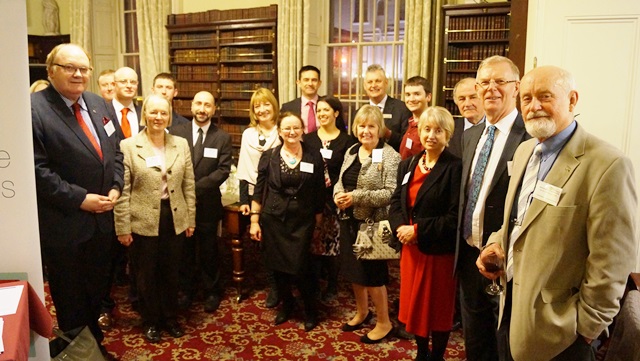 Members from north and south of the Irish Border at the Royal Irish Academy
Members from north and south of the Irish Border at the Royal Irish Academy
Dr Mark Downs FSB, chief executive, Society of Biology provided an overview of the Society's important contributions to biology and of its impact upon society in general. Dr Glenn Dickson FSB, a current committee member and a previous chairman of the Northern Ireland (NI) branch informed members in the South of Ireland that the Northern Ireland branch of the Society of Biology has approximately 300 members in various membership grades with most members being focused in city areas but also widely distributed throughout Northern Ireland. Approximately half are in the membership grade, 70 in student grade and 60 in affiliate and also associate grades. The branch has around two dozen Fellows. He indicated that the NI branch was interested in attracting members from across society, educational establishments, government and industry.
The NI branch has organised a calendar of local events for decades and more recently HQ has heightened its participation and support of events with local branches such as the recent Bugs for Life - Menu of the Future weekend event held in Belfast. The NI branch programme of events runs from October to September each year. It is a blend of lectures and outings of interest to the membership. Examples from this year's programme include a lecture on Food Security by Professor Chris Elliott, Queen's University Belfast, an industrial visit to the Portaferry Marine Laboratory, participation in the Sentinus Young Innovators Competition, new syllabus support for 'A' Level teachers STEMNET and a summer outing to Rathlin Island Bird Protection Sanctuary. David Urry MSB, regional coordinator provided extensive information on the re-organisation by HQ of Society of Biology branches and support infrastructure.
Professor Gerry McKenna RIA FSB focused on opportunities for Society of Biology members in the Republic of Ireland to become involved and highlighted possible funding opportunities to facilitate this. Dr Joe Collins expressed his delight with his earlier participation in NI branch activities and his desire to see the creation of a Society of Biology Branch in Southern Ireland to help facilitate joint activities, important for the future of biology. Dr Dickson indicated that the committee and members of the NI branch were enthusiastic in promoting Society of Biology networking across Ireland as this would be beneficial to the entire membership interested in biology. Members from Southern Ireland demonstrated an interest in participating in aspects of the current programme.
Dr Glenn Dickson CBiol FSB
Metabolomics Lecture & AGM
22 October 2014
The 2014 branch AGM was followed by a fascinating lecture on the applications of metabolomics by former branch secretary Dr Brian Green, pictured below, who is based within the Advanced ASSET Technology Centre at the Institute for Global Food Security at Queen's University Belfast.
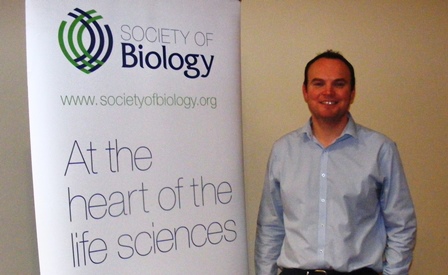
Green explained that the "metabolome" is the complete set of metabolites in a biological system, comprised of an extremely diverse range of chemical compounds. This makes it particularly challenging to analyse in its entirety. With the right techniques, the chemical fingerprint in an organism at any one time can be carefully interpreted to tell us a great deal about the "health" of that organism. This exciting new approach is being used to study human diseases, with the goal to find unique patterns of metabolites that could be used to diagnose specific diseases.
Metabolomics (i.e. the characterisation of the metabolome) is now being taken very seriously as a research tool – and is viewed by researchers as a 'surrogate for physiology'. Green outlined how his research group have been using metabolomics to profile human dementia, including cases of prodromal Alzheimer's disease. The impressive power of the technology was exemplified by statistical models which accurately predicted cases of dementia following the analysis of either blood or brain specimens.
The talk concluded with an audience discussion about the many potential applications of metabolomics to study different areas of biology from microorganisms to cancer.
Dr Richard Briggs CBiol FSB
Science and Stormont Conference
13 October 2014
This event was hosted by the Royal Society of Chemistry and facilitated by Basil McCrea MLA, Chair of the All-Party Group on Science and Technology at Stormont the seat of the Northern Ireland Assembly. It was attended by the learned societies for science, technology, engineering and mathematics (STEM subjects) along with several Northern Ireland Assembly members (MLAs). The Northern Ireland branch of the Society of Biology was well represented and there was an opportunity to meet the Society's Director of Parliamentary Affairs Dr Stephen Benn FSB who maintains relationships with the UK Government in order to promote biology and the Society.
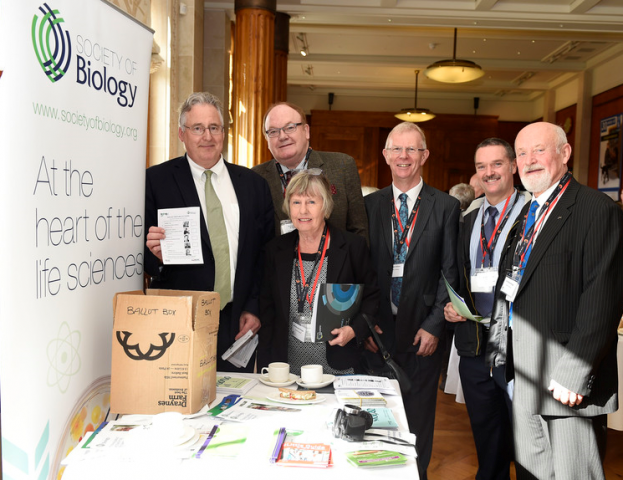 Dr Stephen Benn FSB the Society's Director of Parliamentary affairs with members of the Northern Ireland Branch
Dr Stephen Benn FSB the Society's Director of Parliamentary affairs with members of the Northern Ireland Branch
The theme of the conference was "Science Education in Northern Ireland". In addition to formal presentations spanning primary, secondary and tertiary education in the province, there were two lively panel Q&A sessions. Speakers included distinguished representatives from all levels of science education along with a presentation by Steve Orr of the Northern Ireland Science Park. The importance of science in the curriculum along with a sound science background in primary school teachers was emphasised. The focus of discussions on tertiary education highlighted the likelihood of a future funding shortfall and a fear that this could lead to a cut in student numbers and/or increases in university fees. This point was emphasised in a presentation by Professor Gerry McKenna FSB representing the Royal Irish Academy. The presentations led to lively and productive discussions providing good food for thought by all present.
Dr Richard Briggs CBiol FSB FLS
Wildlife Meeting
24 October 2014
In our annual joint meeting with the County Armagh Wildlife Society (CAWS), veterinary surgeon Dr Joseph Collins FSB gave this year's talk. His subject was 'Selected aspects of equine welfare in Ireland' and was attended by over 50 people from both the Society and CAWS along with a party of students from the College of Agriculture Food and Rural Enterprise.
Dr Collins presented his view of the welfare of horses in Ireland – touching on key issues such as welfare legislation and the responsibilities of horse owners; the needs of horses and how these are modified by domestication; horse-human and horse-environment relationships; and end-of-life issues – how we dispose of unwanted horses. He acknowledged the support of UK charities World Horse Welfare and the Donkey Sanctuary for his work.
Horse can be damaging to land if intensively grazed long-term on the same area, yet intensively farmed land is often too rich for their needs leading to medically challenging conditions such as obesity. There is also increasing concern about the potential adverse effects (on human and environmental health) of the medicines we use to treat them, for parasites for example.
In a wide-ranging presentation the key final message was of the importance of measuring and managing both our horses and those who would keep them – so that the former 'live a good life' and the latter are held to their duty of care to provide same.
Dr Richard Briggs CBiol FSB and Dr J A Collins CBiol CSci FSB
Giant's Causeway
7 June 2014
Our summer outing was to Giants Causeway and the new prize winning visitor centre on the north Antrim coast. The centre blends beautifully into the landscape and has a state of the art interior, with interactive displays of local geology, natural history and folklore. Head conservation officer, Dr Clifford Henry, led a comprehensive tour, which included a 3km walk with spectacular views of the Causeway's basalt columns and extensive biodiversity.
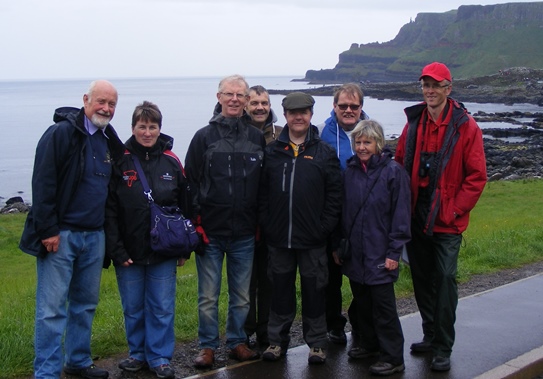
The area was declared a World Heritage Site by UNESCO in 1986 and a National Nature Reserve in 1987. It is a geological wonder, with over 40,000 interlocking hexagonal basalt columns providing a glimpse into the earth's most ancient past - an epic 60 million year-old legacy to the cooling and shrinking of successive lava flows.
The recently discovered pools of stromatolites, living fossils dating back 3 billion years, were of particular interest to the biologists. They are cyanobacteria, thought to have converted the Earth's early reducing atmosphere into an oxidizing one, which dramatically changed the composition of life on Earth.
The flora seen included thyme broomrape (Orobanche alba) along with several species of orchid. These included the not so common Irish ladies-tresses orchid Spiranthes romanzoffiana. A range of Lepidoptera can also be found including the minute nettle-tap moth, Anthophila fabriciana and molluscs such as the grove snail, Cepaea nemoralis and the narrow-mouthed whorl snail, Vertigo angustior.
In addition to the features of scientific interest, the group was entertained by folklore stories of the causeway including the famous confrontation between the Irish giant Finn MacCool and the Scottish giant Benandonner. Although the weather was somewhat damp, this was a very successful trip.
Dr Richard Briggs CBiol FSB FLS
Mammal conservation in the EU
11-16 August 2013
The Society sponsored a lecture from András Demeter, directorate general for the environment, European Commission, at the 11th International Mammalogical Congress at Queen's University Belfast. Over 120 delegates from the congress and local branch attended this enthusiastic review of established directives and current directions in European conservation.
The presentation focused on mammals (the conference theme) but also provided a detailed overview of the EU Habitats Directive and the Natura 2000 network. Natura 2000 is the largest science-based, legally binding ecological/conservation network in the world; it consists of over 26000 sites covering almost 18% of the EU's landmass and more than 145000 km2 of its seas. 9000 Natura 2000 sites across 9 biogeographical regions include mammalian species as features identified in statutory site designations. Under the habitats directive 128 species of mammal need strict protection with less than 15% in favourable and 40% in unfavourable conservation status.
Large gaps in our understanding of the conservation status of mammal species, particularly marine species, in Europe remain. We also heard about the challenges of large carnivore conservation in Europe.
An overview of how LIFE funding instruments had been used to support mammalian research and conservation was also provided. The presentation concluded with a live demonstration of the Natura 2000 Viewer which provides electronic access to information on about 26000 sites in the network.

From the left: Professor Ian Montgomery, conference organiser; Dr Dai Roberts, chair of the Northern Ireland branch; András Demeter, directorate general for the environment, European Commission.
Dr Dai Roberts CBiol FSB
Forensic Science Northern Ireland
29 May 2013
Despite, or perhaps because of its gruesome nature, forensic science has held the public imagination for well over a hundred years thanks to Conan Doyle and Sherlock Holmes. Doyle's hero may have been inspired by his mentors Dr Joseph Bell who lectured at the Medical School, University of Edinburgh or Sir Henry Littlejohn, lecturer in forensic medicine, Royal College of Surgeons. A number of TV dramas continue to maintain this fascination for newer generations. Members were treated to the 'real thing' in a recent visit to Forensic Science Northern Ireland.
Forensic science (FS) aims to provide the judicial process with objective scientific analysis of evidence at scenes of serious crimes using the latest techniques available. Biologists play a pivotal role in forensic investigations and uniquely interact with all other forensic disciplines as complex cases develop. Members who attended the event included senior academics and junior colleagues aspiring to develop a career in FS.
After an introduction on approaches and tools used in FS, visitors donned white oversuits and undertook a simulated investigation at a crime scene, and laboratory studies of blood splash patterns and fibre sampling and microscopy. The practical work was followed by a debriefing trying to interpret information gathered at the crime scene and elsewhere to build an accurate picture of events relevant to the investigation. This demonstrated that investigating crime was not as quick and clear cut as often portrayed in fiction but involved painstaking protracted effort and great attention to detail.
I would like to thank the staff at FSNI who gave so generously of their time to ensure a particularly informative experience.
Dr Dai Roberts CBiol FSB
Bumblebees: what's all the buzz about?
16 October 2012
Our Biology Week lecture was held jointly with the County Armagh Wildlife Society. Dr Mark Brown, reader in evolutionary ecology and conservation, is an international expert on social insects with a particular interest in bumblebees.
A packed audience were treated to a fascinating lecture on this endangered genus. Mark initially explained the phylogeny of bees in the Apidae family; only a few are social and these include the honey bees and bumblebees. The bumblebee has an advantage over the other bee species in that it can generate extra heat in its body allowing it to fly even in very cool conditions. However the annual nature of its life cycle, with only the mated females hibernating, leaves the species sensitive to loss. In contrast, honeybees overwinter as a colony and this is one of the reasons why honeybees develop large food stores.
The horticultural industry (estimated in billions of pounds) is crucially dependent on the availability of sufficient insect pollinators. Conservationists are concerned that over the last 30 years the number of bumblebees has dropped considerably, factors include: competition from other bee species and the presence of parasites which can reduce fertility. In addition, bumblebees normally thrive in wild areas that are populated with a wide variety of flowering plants; this type of habitat is now drastically reduced due to widespread land-use changes in agriculture and urbanisation (98% in the UK and 99% in the USA)!
The talk was completed by a lively discussion of the issues raised.
Dr Brian Green CBiol MSB
